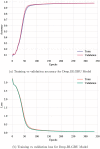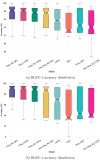End-to-end antigenic variant generation for H1N1 influenza HA protein using sequence to sequence models
- PMID: 35344562
- PMCID: PMC8959165
- DOI: 10.1371/journal.pone.0266198
End-to-end antigenic variant generation for H1N1 influenza HA protein using sequence to sequence models
Abstract
The growing risk of new variants of the influenza A virus is the most significant to public health. The risk imposed from new variants may have been lethal, as witnessed in the year 2009. Even though the improvement in predicting antigenicity of influenza viruses has rapidly progressed, few studies employed deep learning methodologies. The most recent literature mostly relied on classification techniques, while a model that generates the HA protein of the antigenic variant is not developed. However, the antigenic pair of influenza virus A can be determined in a laboratory setup, the process needs a tremendous amount of time and labor. Antigenic shift and drift which are caused by changes in surface protein favored the influenza A virus in evading immunity. The high frequency of the minor changes in the surface protein poses a challenge to identifying the antigenic variant of an emerging virus. These changes slow down vaccine selection and the manufacturing process. In this vein, the proposed model could help save the time and efforts exerted to identify the antigenic pair of the influenza virus. The proposed model utilized an end-to-end learning methodology relying on deep sequence-to-sequence architecture to generate the antigenic variant of a given influenza A virus using surface protein. Employing the BLEU score to evaluate the generated HA protein of the antigenic variant of influenza virus A against the actual variant, the proposed model achieved a mean accuracy of 97.57%.
Conflict of interest statement
The authors have declared that no competing interests exist.
Figures





Similar articles
-
Multi-task learning sparse group lasso: a method for quantifying antigenicity of influenza A(H1N1) virus using mutations and variations in glycosylation of Hemagglutinin.BMC Bioinformatics. 2020 May 11;21(1):182. doi: 10.1186/s12859-020-3527-5. BMC Bioinformatics. 2020. PMID: 32393178 Free PMC article.
-
Immune Escape Adaptive Mutations in Hemagglutinin Are Responsible for the Antigenic Drift of Eurasian Avian-Like H1N1 Swine Influenza Viruses.J Virol. 2022 Aug 24;96(16):e0097122. doi: 10.1128/jvi.00971-22. Epub 2022 Aug 2. J Virol. 2022. PMID: 35916512 Free PMC article.
-
Deep Sequencing Reveals Potential Antigenic Variants at Low Frequencies in Influenza A Virus-Infected Humans.J Virol. 2016 Jan 6;90(7):3355-65. doi: 10.1128/JVI.03248-15. J Virol. 2016. PMID: 26739054 Free PMC article.
-
Antigenically Diverse Swine Origin H1N1 Variant Influenza Viruses Exhibit Differential Ferret Pathogenesis and Transmission Phenotypes.J Virol. 2018 May 14;92(11):e00095-18. doi: 10.1128/JVI.00095-18. Print 2018 Jun 1. J Virol. 2018. PMID: 29540597 Free PMC article.
-
Antigenic drift of hemagglutinin and neuraminidase in seasonal H1N1 influenza viruses from Saudi Arabia in 2014 to 2015.J Med Virol. 2020 Dec;92(12):3016-3027. doi: 10.1002/jmv.25759. Epub 2020 Apr 1. J Med Virol. 2020. PMID: 32159230 Free PMC article.
Cited by
-
MAIVeSS: streamlined selection of antigenically matched, high-yield viruses for seasonal influenza vaccine production.Nat Commun. 2024 Feb 6;15(1):1128. doi: 10.1038/s41467-024-45145-x. Nat Commun. 2024. PMID: 38321021 Free PMC article.
References
-
- Sun Honglei et al.. “Prevalent Eurasian avian-like H1N1 swine influenza virus with 2009 pandemic viral genes facilitating human infection”. In: Proceedings of the National Academy of Sciences 117.29 (2020), pp. 17204–17210. eprint: https://www.pnas.org/doi/pdf/10.1073/pnas.1921186117. url: https://www.pnas.org/doi/abs/10.1073/pnas.1921186117. doi: 10.1073/pnas.1921186117 - DOI - DOI - DOI - PMC - PubMed
-
- Tenforde Mark W et al.. “Effect of Antigenic Drift on Influenza Vaccine Effectiveness in the United States-2019–2020”. In: Clinical Infectious Diseases 73.11 (Dec. 2020), e4244–e4250. issn: 1058-4838. eprint: https://academic.oup.com/cid/article-pdf/73/11/e4244/41607988/ciaa1884.pdf. url: 10.1093/cid/ciaa1884. doi: 10.1093/cid/ciaa1884 - DOI - DOI - PMC - PubMed
-
- Valkenburg Sophie A and Poon Leo LM. “Exploring the landscape of immune responses to influenza infection and vaccination”. In: Nature Medicine (2022), pp. 1–2. - PubMed
MeSH terms
Substances
LinkOut - more resources
Full Text Sources

